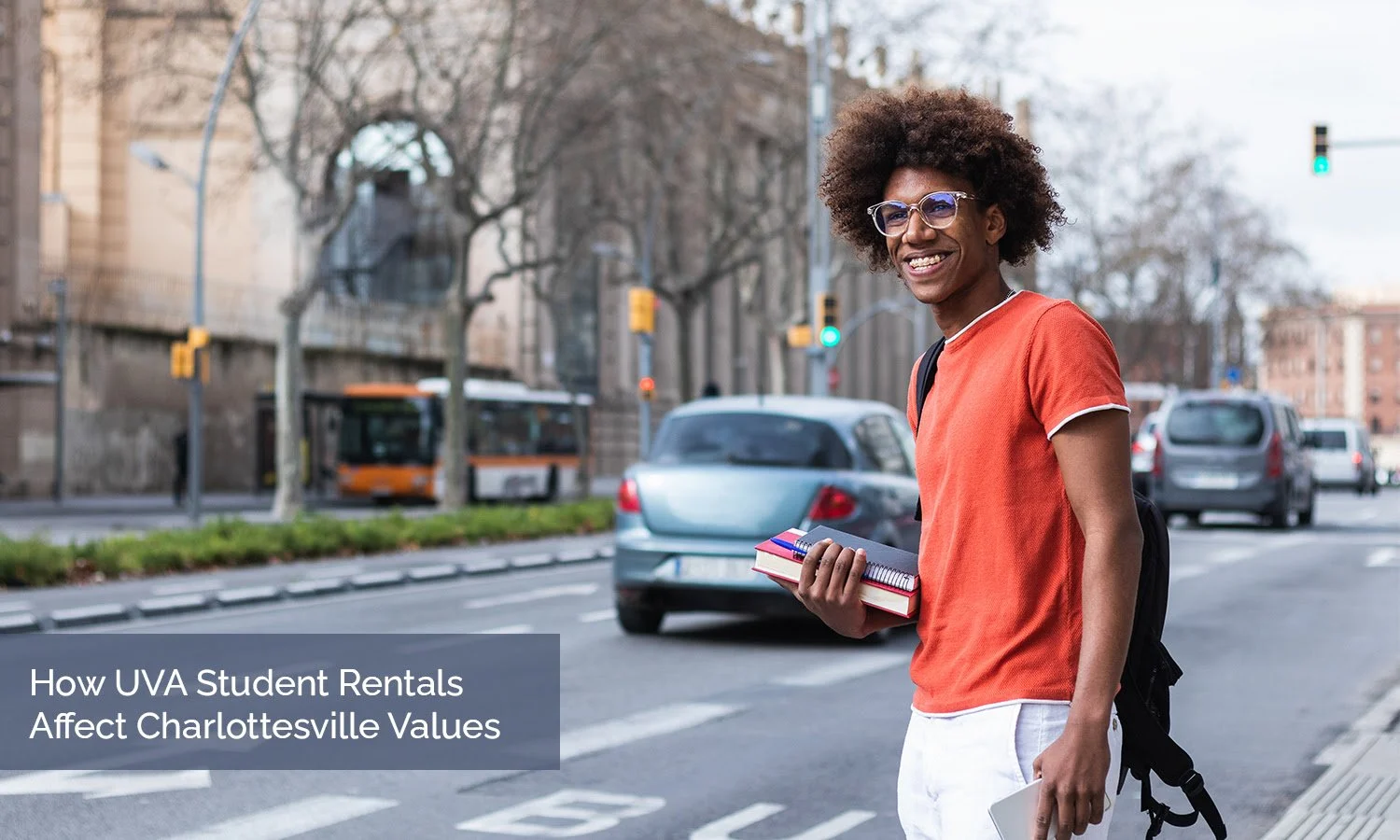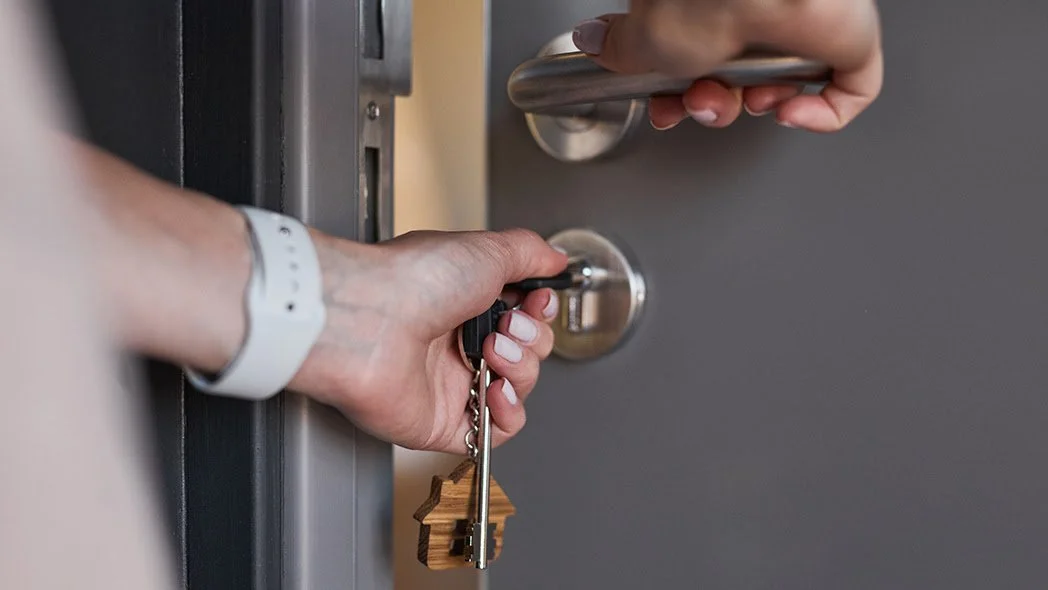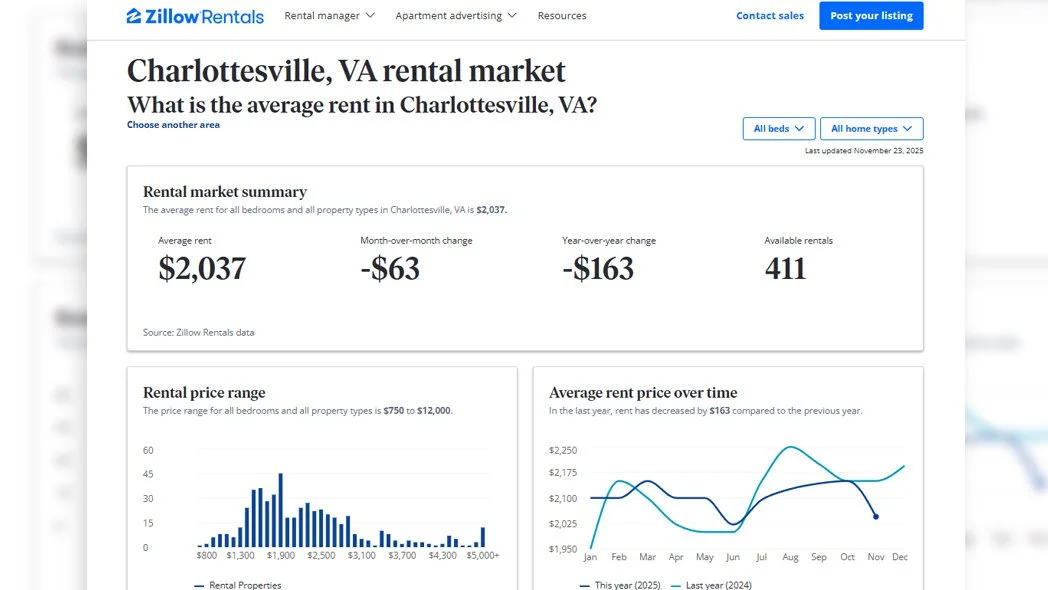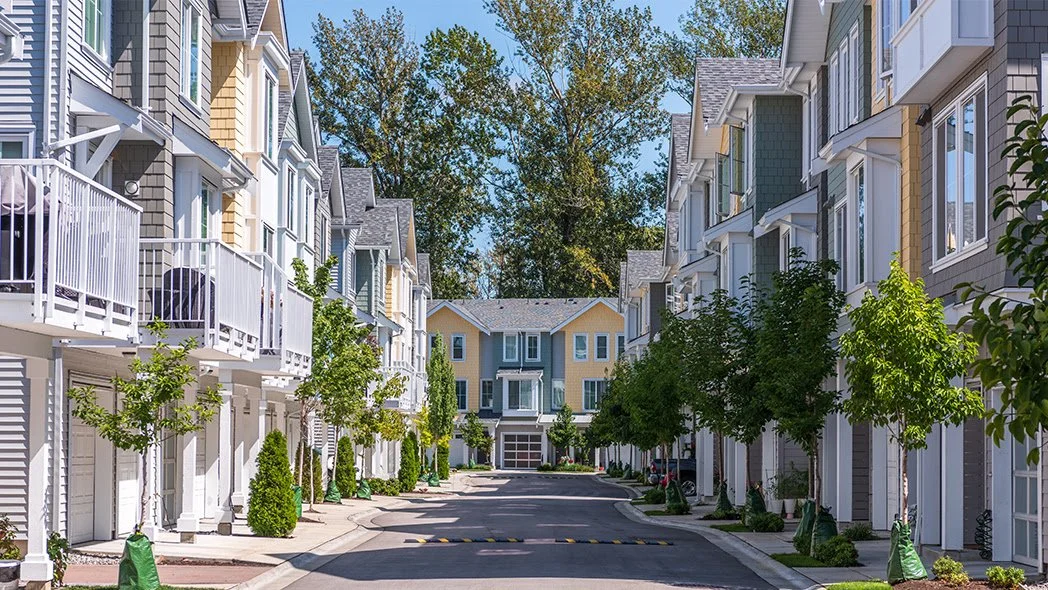How UVA Student Rentals Affect Charlottesville Values
Charlottesville homeowners are watching rental signs pop up on one block, then the next and then the next. At the same time, their property tax bills are climbing year after year. Families who grew up here (in the same neighborhoods where their parents bought homes on a teacher's salary) can't afford to live in them anymore. Investors are looking for double-digit returns, and the residents who've been around for decades are asking themselves if their community can survive this.
Around 12,500 students need off-campus housing each year, and when they move into a neighborhood, property values start to change. Some streets see prices climb, and others see them drop - it all depends on what's going on in your own block. A three-bedroom house can illustrate this. A family might pay $450,000 for it. An investor could pay $495,000 for that same house because renting out each room separately brings in around $2,700 per month. Properties like these usually take more of a beating from normal wear and tear and also rack up far more neighbor complaints than a single-family home would.
Every block ends up with winners and losers because of this. Some homeowners come out ahead when the investor demand pushes their home values higher. Others get priced out of their own neighborhoods, or worse, they get stuck next to a property that gets a new group of tenants each August. The rental market moves along on a yearly schedule (leases usually get signed in February and March), and that means families who wait until summer to start on their house hunt are going to find limited choices and much higher prices. Whether you own property, are planning to buy or just want to understand why your neighborhood doesn't feel the same as it did five years ago, you'll have to know about how student rentals actually work. Student rentals drive economic growth and neighborhood disruption at the same time!
Here's how student housing is changing Charlottesville's property market and neighborhood values.
Why Students Pay More for Rent
Student rental properties in Charlottesville have an interesting financial setup. A landlord with a four-bedroom house can rent it out to students at around $800 per bedroom, and that's over $3,200 each month. The same house, when rented to a family instead, would probably only bring in around $2,400 total.
Student rental houses have an interesting pricing quirk. They sell for less per square foot than comparable homes in family neighborhoods in most markets. Wear and tear is usually the main culprit behind this discount. When student tenants move in and out year after year, these properties take a beating and show the accumulated damage.
Neighborhoods like JPA and the areas along Preston Avenue are great examples of this wear and tear. A house that's been used as a student rental for a few years is almost sure to need new carpet and fresh paint throughout the entire place. Every room will show the damage. The kitchen appliances are usually pretty worn out, too, and will most likely need to be replaced.
Investors continue to buy up these properties at a steady pace, even with the possible downsides. The bedroom-by-bedroom rental model makes the numbers work out well enough that it's still a solid investment option. The maintenance costs will be higher, and the resale value later won't be quite as strong as it would be with a traditional rental property. The monthly cash flow from this rental style tends to make up for those drawbacks, though. A property that generates $3,200 per month instead of $2,400 means an extra $9,600 of cash flow each year.
This income gap explains why student rentals continue to spread into more Charlottesville neighborhoods. The profit is too high for landlords to pass up, even when they know that they're signing up for extra work and complications.
The February to April Rush
The rental market in Charlottesville follows the same pattern year after year. You should probably get familiar with how this cycle plays out before buying a rental property near campus. The leasing season for students gets busiest between February and April, right when everyone plans for the next academic year. During this 3-month window, it's pretty wild as students and their families race to nail down housing before the fall classes start.
Home prices in the neighborhoods close to campus can jump anywhere from 10 - 15% during that February to April buying rush if you compare them to what those same properties would go for in the fall months - it's a large price increase to account for when you're in the market for one of these homes. What ends up happening is that multiple buyers will compete for the same handful of properties and push the prices up even higher than they already are. All this competition also creates urgency in the market, which works heavily in the seller's favor.
Families that want to buy a home in these neighborhoods have to compete directly with investors during the peak buying months, and it's not an easy competition to win. Many of these investors arrive with cash that's already approved and ready to close fast. Traditional homebuyers have a much harder battle in this environment because they need to line up the financing first (which takes time). This delay gives cash buyers an edge for deals that close fast.
Timing really matters with student rental properties. Families that hold off until the summer to start their search usually wind up disappointed with what's still on the market. The best properties get snatched up early in the season, and by the time July or August comes around, there's not much left to choose from in the areas where students actually want to live. Most landlords and property investors have already closed on their deals months ahead of that.
This cycle repeats every year in Charlottesville, and timing matters way more here than in most other college towns. Shopping for a home on your own timeline as you stay focused on the areas close to campus probably won't work out the way you want. The market moves with the academic calendar, and your personal schedule doesn't factor into it at all!
Families Are Being Pushed Out of Town
The student rental market in Charlottesville has created a tough problem for just about anyone who works in the city and wants to buy a home close to where they work. Local schoolteachers earn around $50,000 a year on average, and nurses at UVA Health make roughly the same amount. City workers who take care of the day-to-day operations throughout Charlottesville face the same cost problems when they start to look for a home in the area.
Families all over the area are being pushed out of neighborhoods that used to work well for them. Fifeville is a perfect example of how this happens. Not too long ago, it was filled with decent starter homes that working families could actually afford to buy. The median price of a home has climbed well past what most local workers can realistically manage on their salary.
Regular home buyers are being priced out of the market, and the financial gap continues to get wider. For a $300,000 house, an investor can justify that price tag pretty easily if they plan to rent it out to students. A family that has to make the mortgage payment on it each month is looking at a different situation. Student rentals bring in a lot more cash flow than traditional long-term rentals do, and that means investors have a lot more room in their budget to outbid regular buyers.
Most of these families eventually move farther out to areas like Greene County or Fluvanna County, where the housing prices are actually affordable. They trade what used to be a short commute for a much longer drive to work every day.
Kids have to switch schools when their families relocate to a new area. Parents see less and less of their neighbors and of their longtime friends - in most cases, they lose touch with them completely. Those strong community connections that took years to build slowly start to fade away. A teacher who used to live just 5 minutes from work might now spend 40 minutes in the car every morning just to get there.
Tax Benefits Come with a Heavy Cost
Student rentals actually bring in a lot more property tax revenue. When a regular home gets turned into student housing, the property value usually goes up. Landlords can rent to multiple tenants all at once, and that pushes up the assessed value of the property. With a higher assessed value, the city gets to bring in more tax dollars from that same property each year. Charlottesville needs this tax money to fund local schools and to run everything - we're talking about roads, parks, water systems and the whole setup.
Student rentals do have some downsides, though. Code enforcement officers need to watch these properties a lot more closely because tenants move in and out all year long - and each house usually holds many more residents than a standard single-family home. The city's infrastructure feels the effects too. All these extra residents live on the same streets and use the same water and sewer systems, so everything wears out much faster than it normally would.
The worst part is what it does to the community itself. Families who have lived in these neighborhoods for years have moved out steadily over time. These are the same neighbors who used to run the neighborhood watch programs, put together the block parties and know everyone on the street by first name. They were also the type of neighbors who'd watch your house for you anytime you had to leave town.
A few neighborhoods around here have lost a lot of families over the years, so the city eventually had to shut down its elementary schools. The school board looks at a pretty basic numbers problem at that point - they have to close buildings and consolidate everyone into other locations - there aren't enough kids in the area.
City planners face a tough balancing act with student housing developments. On one side, all that extra tax revenue from these buildings pays for a lot of important services that everyone in Charlottesville relies on every day. On the other side, these same buildings put extra strain on city resources, and they change the character of the neighborhoods where they are built. The money helps in the short term and makes it possible to run services. But as the years go by, the community connections and stable neighborhood feel just get weaker and weaker.
How Property Values Change Over Time
Student rental areas in Charlottesville have performed quite differently from the rest of the property market over the past decade. Family-friendly neighborhoods have gone up in value steadily; their values have climbed at a much more predictable and steady pace. Student rental zones work differently - they've been through some fairly dramatic swings up and down during that same period.
These investment properties are only as stable as UVA's enrollment numbers. If the university stops growing its student body, or if online classes become more permanent and fewer of the students actually need off-campus housing, demand in those rental neighborhoods would start to decline, and property values would probably drop right along with it.
It makes sense to look at what's happened in other college towns with similar markets. Ann Arbor's student housing market has been around for decades now, and it's had the time to go through different cycles and changes. Chapel Hill has seen whole neighborhoods actually flip from student rentals back to single-family homes when what buyers wanted started to change.
Investors have caught on to this pattern, and quite a few of them operate differently now. Rather than target the blocks right next to campus, they look at homes that are 3 to 5 miles away from the university. They want to get in before student housing starts to expand outward into those neighborhoods. The payoff takes a bit longer to arrive. But it sets them up ahead of the next wave of student demand.
Where your property value goes over the next 10 or 20 years depends quite a bit on which type of home you bought and where it's located. Properties that are close to campus will probably always have students who want to rent them, so demand stays pretty steady over time. Properties that are farther away from campus can be more flexible and work well for different types of tenants as the market changes. The difference matters if you're planning to hold onto your investment property for a few years or more.
Moving to Charlottesville?
Charlottesville has faced a tough question. The city wants to maintain the benefits of a big university right in town and also protect the residential neighborhoods that give this place its character. Everyone involved has different goals, and no perfect answer will make all sides happy. These conversations need to continue, though, because the residents who live here (the ones who own a home, rent an apartment, or are raising a family) all have a stake in where the community ends up. The property you buy and what you do with it matters quite a bit, and each choice feeds into the bigger picture of what Charlottesville will look like in a decade or two.
Every neighborhood in Charlottesville has its own personality, and the history runs deep across each of them. Local knowledge matters when you're figuring out Charlottesville’s real estate market, and we've spent years building up that expertise at the Justin Landis Group. Your goals might lean toward a quiet suburban property, or you might want to stay closer to downtown, where everything is happening. In either case, we can talk through the options and help you land on something that actually fits what you need. Give the Justin Landis Group a call, and we'll show you what Charlottesville has for you.







